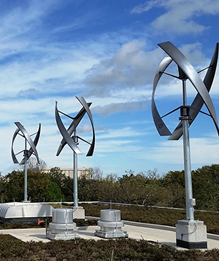I’ve been following the terrible weather situation in Texas, watching as the people there have been struggling with fierce cold, snow, and ice that’s well beyond what they’re used to. Of course, the big story in Texas is the inability of their power grid to keep up with demand.
Wind is a big part of that grid, and accounts for a bit under one-quarter of Texas energy use. The adverse weather conditions have put a crimp in the wind supply, as turbines have frozen up, but wind has actually done better than natural gas (the main source of energy there) and nuclear in terms of meeting winter output expectations.
Anyway, since wind power is in the news, I thought I’d read up a bit on it. And ended up deciding to do a little primer on it.
Wind power has, of course, been around for a good long time. Think of all those windmills in the Netherlands. And those windpumps you see in pictures of farms and ranches, used to help water the stock. What those big wind turbines we see popping up are not used for a specific mechanical task, but are used, via a generator, to turn wind into electricity.
The US Department of Energy has a lot of good, basic info on wind, which is where I found this overall definition of how things work:
A wind turbine turns wind energy into electricity using the aerodynamic force from the rotor blades, which work like an airplane wing or helicopter rotor blade. When wind flows across the blade, the air
pressure on one side of the blade decreases. The difference in air pressure across the two sides of the blade creates both lift and drag. The force of the lift is stronger than the drag and this causes the rotor to spin. The rotor connects to the generator, either directly (if it’s a direct drive turbine) or through a shaft and a series of gears (a gearbox) that speed up the rotation and allow for a physically smaller generator. This translation of aerodynamic force to rotation of a generator creates electricity. (Source: energy.gov)
There are two main types of wind turbines. I was most familiar with the horizontal-axis version. That’s the one that’s usually pictured, and the one used at the wind farm in my area in Upstate New York. The horizontal-axis turbines face the wind. On the other hand, vertical-axis turbines – which include this “egg-beater” type – are omnidirectional.
Wind turbines are land-based or offshore, and distributed or not. What we mean by land-based or offshore is pretty obvious. (One if by land, two if by sea…) And they’re generally aggregated into farms that provide bulk energy. Distributed turbines that are for smaller scale use. They’re “installed on the ‘customer’ side of the electric meter or are installed at or near where the energy they produce will be used.”
Texas is actually an excellent place for wind energy because, with its topography, they have an awful lot of wind. And once they’ve invested in hardening their turbines so they can better operate under harsh weather conditions, they’ll be in great shape to withstand future bouts of awful weather. Wind turbines can obviously stand up to the rigors of cold and snow, as they work well in cold places. How do they do it?
In Canada, where wind turbines can experience icing up to 20% of the time in winter months, special “cold weather packages” are installed to provide heating to turbine components such as the gearbox, yaw and pitch motors and battery, according to the Canadian government. This can allow them to operate in temperatures down to minus 22 degrees Fahrenheit (minus 30 Celsius).
To prevent icing on rotor blades — which cause the blades to catch air less efficiently and to generate less power — heating and water-resistant coatings are used.
One Swedish company, Skellefteå Kraft, which has experimented with operating wind turbines in the Arctic, coats turbine blades with thin layers of carbon fiber which are then heated to prevent ice from forming. Another method used by the company is to circulate hot air inside the blades. (Source: Forbes)
As with so many things in life, there’s a risk-reward calculation at play here.
Meanwhile, my thoughts are with the people in Texas who have been enduring so much. Winters are no trip to the beach in Upstate New York, but we’re pretty well used to it. Sure, there are occasional power outages, but we mostly get through our admittedly brutal winters without having to worry about heat, light, and flushing the toilet.

 pressure on one side of the blade decreases. The difference in air pressure across the two sides of the blade creates both lift and drag. The force of the lift is stronger than the drag and this causes the rotor to spin. The rotor connects to the generator, either directly (if it’s a direct drive turbine) or through a shaft and a series of gears (a gearbox) that speed up the rotation and allow for a physically smaller generator. This translation of aerodynamic force to rotation of a generator creates electricity. (Source:
pressure on one side of the blade decreases. The difference in air pressure across the two sides of the blade creates both lift and drag. The force of the lift is stronger than the drag and this causes the rotor to spin. The rotor connects to the generator, either directly (if it’s a direct drive turbine) or through a shaft and a series of gears (a gearbox) that speed up the rotation and allow for a physically smaller generator. This translation of aerodynamic force to rotation of a generator creates electricity. (Source: